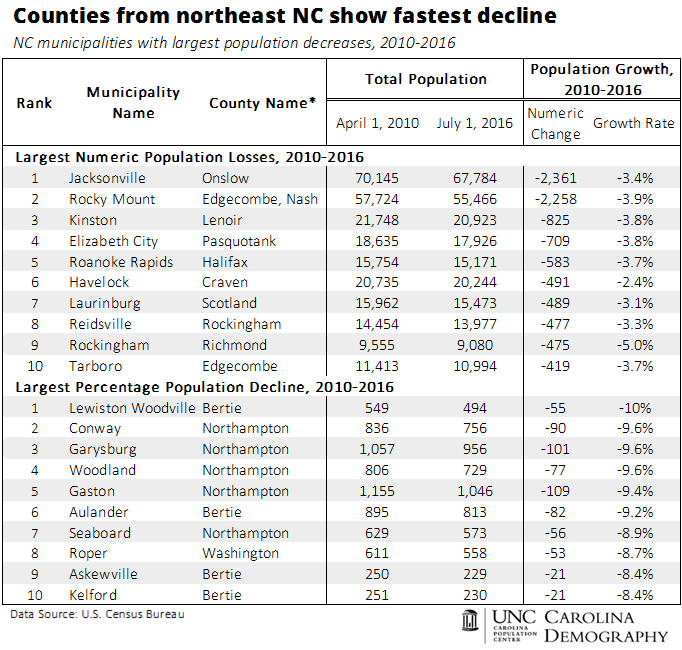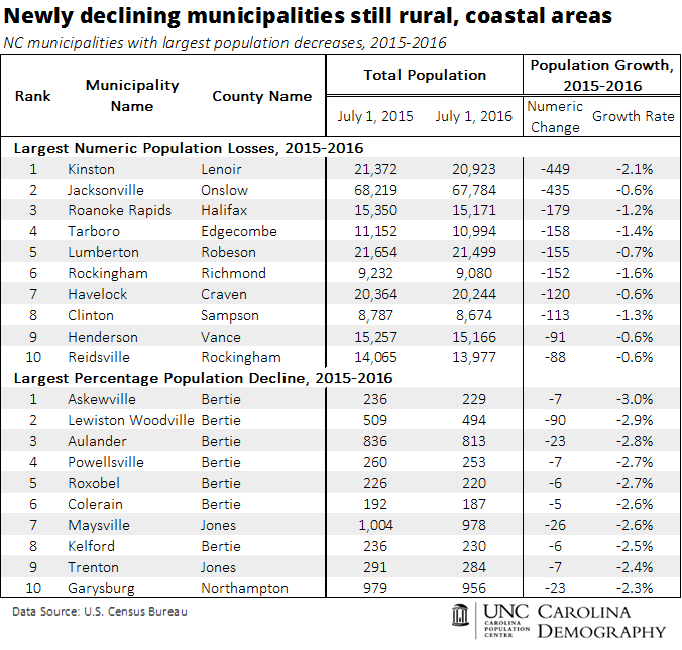Examining Decline in North Carolina’s Municipalities

Despite substantial growth in some areas of the state, a large portion of North Carolina has seen little to no population increase. Of North Carolina’s 553 municipalities, 225, or about 41%, experienced population decline from 2010-2016. An additional 192 reported growth that was lower than 6.4%, the state’s growth rate since 2010. In total, three of every four North Carolina municipalities have lost population or grown slower than the state since 2010. The northeast corridor of the state has been the hardest hit, as the top 10 municipalities with greatest percentage declines from 2010-2016 have been from Bertie, Northampton, or Washington counties.

The Census Bureau and the state demographer at the NC Office of State Budget and Management use different methodologies to produce municipality estimates, which can lead to differing results. A major discrepancy that exists between the two estimates is Jacksonville in Onslow County. According to the U.S. Census Bureau, Jacksonville has had the largest numerical drop in population from 2010-2016, losing nearly 2,400 residents. In contrast, the state demographer at NC OSBM estimates that Jacksonville has grown by over 7,300 residents from 2010-2015 (most recent estimate at state level). It is currently unknown exactly why such a large discrepancy exists and we do not know which is closest to the true underlying population. (For this, we need to wait for the 2020 Census.)
Many of the municipalities with the greatest losses since 2010 are also represented in the following table highlighting population losses between 2015 and 2016. While this similarity indicates that the trend towards decline in these areas is not likely to cease, some municipalities may be experiencing a “leveling out” from large population drops. Rocky Mount only lost an estimated 77 residents from 2015-2016, after losing an average of 437 residents annually since 2010. Elizabeth City and Laurinburg – also among those with the greatest losses since 2010 – reported modest gains from 2015-2016. A number of other municipalities also demonstrated this trend, which will be explored in the following post.
Municipalities in Bertie and Northampton counties continued to report the greatest percentage declines in this single-year period. Three new municipalities from Bertie County – Powellsville, Roxobel, and Colerain – have appeared on the top 10 list, demonstrating the nearly universal experience of population decline across the county. The municipalities from Northampton County which they replaced – Conway, Gaston, and Seaboard – still lost over 2% of their population from 2015-2016. Two municipalities from Jones County are also now represented, Trenton and Maysville. Jones County, the fifth-least populous county in the state, has been on a steady decline since the last census.

Projections for Bertie, Northampton, Jones, and Washington County indicate that further population decline is imminent. According to the Census’ data on components of change from 2010 to 2016, each of these counties demonstrated negative natural growth or natural decrease – whereby deaths outnumber births – and net out-migration from the county. This pattern has occurred each year since the last decennial census.
Natural decrease will only increase in these counties, as each contains a large elderly population. Age data from the Census Bureau indicates that 23% of Northampton County’s population is 65 years or older, followed by Washington County (22%), Jones County (20%), and Bertie County (19%). By comparison, only 16% of the population of North Carolina is 65+ years old.
In terms of migration trends, annual data is limited on who is moving out of each of these counties. Historical trends for these counties suggest out-migration is greatest among young, working-age individuals who may be leaving in search of better economic opportunities, as one Bertie County resident observed last year. These patterns further accelerate population decline, as individuals of childbearing age choose not to start families in these areas.
Need help understanding population change and its impacts on your community or business? Carolina Demography offers demographic research tailored to your needs.
Contact us today for a free initial consultation.
Contact UsCategories: Carolina Demographics
Tags: aging, municipalities, natural decrease, out-migration, population decline, population estimates, U.S. Census Bureau

The Center for Women’s Health Research (CWHR) at the University of North Carolina School of Medicine released the 12th edition of our North Carolina Women’s Health Report Card on May 9, 2022. This document is a progress report on the…

Dr. Krista Perreira is a health economist who studies disparities in health, education, and economic well-being. In collaboration with the Urban Institute, she recently co-led a study funded by the Kate B. Reynolds Foundation to study barriers to access to…

Our material helped the NC Local News Lab Fund better understand and then prioritize their funding to better serve existing and future grant recipients in North Carolina. The North Carolina Local News Lab Fund was established in 2017 to strengthen…
Your support is critical to our mission of measuring, understanding, and predicting population change and its impact. Donate to Carolina Demography today.